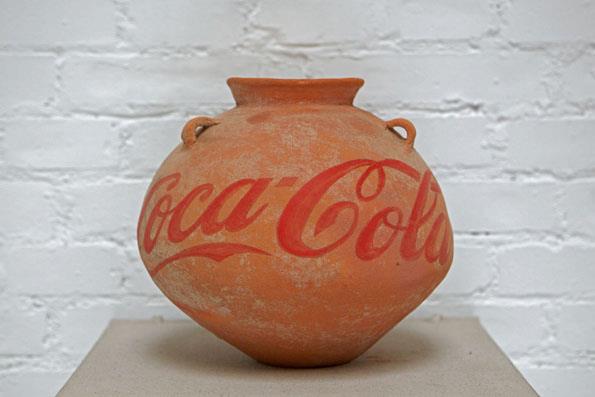
Ai Weiwei, Neolithic vase with Coca-Cola Logo, 2010.
By Tom McGlynn. Read the text as it appeared on Artwrit.com.
Regarding Warhol at the Metropolitan Museum of Art, organized by Marla Prather and independent curator Mark Rosenthal, sets out to frame the artist's influence over concurrent and succeeding generations of artists by using a subject-oriented thematic approach. The discretely chosen group of works includes artists whose intents vary between the pointedly political Hans Haacke to the strategically ironic Damien Hirst. The topics which bracket each grouping of works such as "Daily News: From Banality to Disaster" in the first room to "Portraiture: Celebrity and Power" later on, are helpful in holding together the show's premise of Warhol's undeniable, pervasive influence on a generation of artists -- particularly those who came to the fore in the '60s like Gerhard Richter and Vija Celmins. Celmins is represented here by a small grey painting of a TIME magazine cover representing an early (1965) instance of racial rioting in South Central LA. Her work echoes Warhol's "Birmingham Race Riot," also represented here, from a year earlier. A Richter painting, also in grey, of a three-quarter painting of a cow's head, "Kuh" from 1965, is reminiscent of Warhol's cow wallpaper from 1966. These direct resemblances argue the point of Warhol's impact quite evidently, and one could extrapolate to say that the subject of the prosaic, Pop, became naturalized by his example.
Chronology and resemblance is one way to clearly approach the subject of artistic influence. As one observes the range of works, however, it becomes evident that while the examples were well chosen, the categorical organization of the rooms constricts the efflorescence of Warhol's influence in creatively idiosyncratic ways, from artists as stylistically diverse as Bruce Nauman and Kara Walker. For example, the juxtaposition of a bare-bones Nauman neon piece from 1972 titled "Eat/Death" with a Jean Michel-Basquiat neo-expressionist death's head, "Untitled (Head)" from 1981 seems an overly obvious link and undermines the power of each work in its overly-anecdotal correspondence. The Freudian death drive/consumer impulse, which does seem to underlay a lot of Warhol's production, might have been more subtly explored by playing the Nauman piece off an early Jeff Koons in the show, "New Hoover Deluxe Shampoo Polishers, New Shelton Wet/Dry 10-gallon. Displaced Triple Decker",from 1981-1987. Each of these works use neon to effect a certain cold distancing, which characterizes both death and consumption. The link of materiality might have been stressed in other possible pairings. Rather than presenting Kara Walker's "Black Star Press: Black Star, Black Press, Star, 2004" in proximity to a 1964 "Birmingham Race Riot" (both works including images of racial protest), why not explore the eccentric material with which Walker overlays her images (chocolate) and suggest a more visceral link with Warhol's own use of phenomenal materiality in works such as one of the infamous piss paintings included in the exhibition, "Oxidation Painting" from 1978.
Throughout the wide array of work included in this show, there was a strong sense of impoverished material means that kept re-occurring. Consider a work like Robert Gober's handmade stacks of ostensibly recyclable material "Untitled (Newspapers)," from 1992 or Tom Sachs' 1996 "Chanel Chainsaw." One work presents the prosaic as crafted object, the other as provisional object crafted from a glamorous by-product. Both are fairly unpolished and use base materials. In reviewing many of Andy Warhol's works interspersed throughout the exhibit, one begins to recognize a similar strain of reduced material means and a certain abject material quality to the works chosen. The well known disjunctures in Warhol's printing, offsets and lack of ink, take on a phenomenal, material meaning that typically gets parsed through reams of as art-in-the-age-of-mechanical-reproduction rhetoric. The pop-cultural semiotics of a "Warholian" stance usually overshadow his material choices, which are most often dismissed as incidental. The artist's unique palette and touch, however, becomes viscerally evident in this show and one wonders if a further study of the phenomenology employed in Andy's work might forge some deeper connections in the imagined factories of an American objecthood.
Regarding Warhol: Sixty Artists, Fifty Years
18 September-31 December, 2012
The Metropolitan Museum of Art
New York